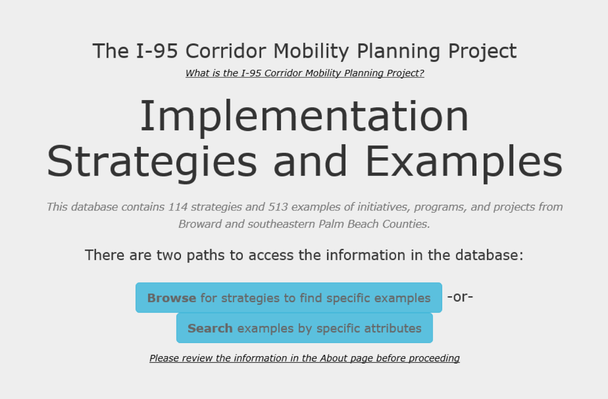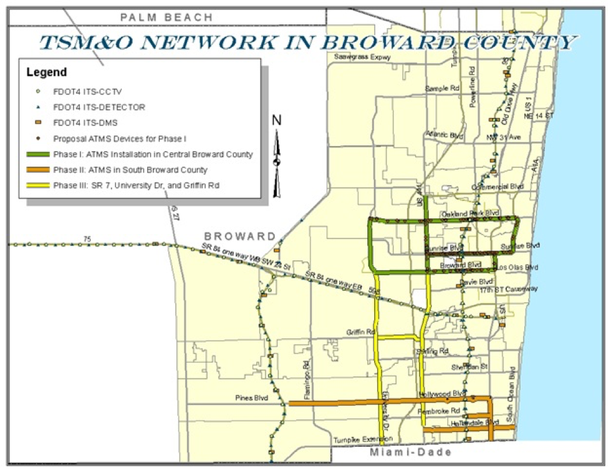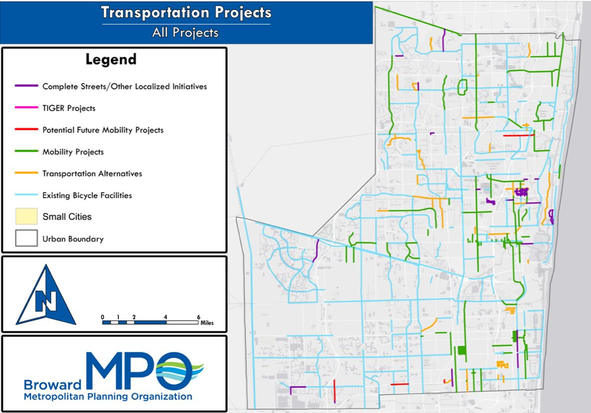Implementation Strategies
In 2013, FDOT and the project team held 20 individual listening sessions with local government and agency stakeholders. The stakeholders shared their visions and goals for transportation and land use, the strategies they were undertaking in pursuit of their goals, and indicators they were using to track success.
From the 2013 listening sessions, the project team compiled and organized an Excel database of over 100 implementation strategies with over 400 examples including visioning efforts, planning studies, educational programs, policies, capital and operational improvements, and coordination initiatives. The project team shared the compiled implementation strategies and examples with the Working Group in 2014. The strategies and examples are now housed in an interactive searchable web-based database tool.
From the 2013 listening sessions, the project team compiled and organized an Excel database of over 100 implementation strategies with over 400 examples including visioning efforts, planning studies, educational programs, policies, capital and operational improvements, and coordination initiatives. The project team shared the compiled implementation strategies and examples with the Working Group in 2014. The strategies and examples are now housed in an interactive searchable web-based database tool.
|
The Implementation Strategies and Examples Web Tool is available at http://i95-kittelson.com. Users can browse for strategies and search for examples by specific attributes. Stakeholders who wish to update their implementation examples can request a login and edit their examples. The project team is currently working on enhancements to the web tool to enhance usability.
|
FDOT Implementation Examples
In early 2016, FDOT initiated an update of the implementation strategies database as part of the project's initial monitoring and evaluation activities. In an effort to lead by example, FDOT updated the more than 100 implementation examples applicable to the Department. The Implementation Strategies Update Tech Memo documents the update process and results.
The updated examples include additional information, including status and links to other websites, where applicable.
A few FDOT examples:
In early 2016, FDOT initiated an update of the implementation strategies database as part of the project's initial monitoring and evaluation activities. In an effort to lead by example, FDOT updated the more than 100 implementation examples applicable to the Department. The Implementation Strategies Update Tech Memo documents the update process and results.
The updated examples include additional information, including status and links to other websites, where applicable.
A few FDOT examples:
FDOT Example |
Timeframe |
Additional Information |
Construct managed lanes on I-95 from Golden Glades Interchange to Broward Blvd (Phase 2) |
Completed |
Completed in April 2016. This project added one lane to I-95 in each direction between I-595 in Broward County and the Miami-Dade County Line by reconfiguring the high occupancy vehicle lane and narrowing three of the four general purpose lanes. The existing high occupancy vehicle lane and additional lane were converted to high occupancy toll lanes, separated from the general purpose lanes by plastic poles. For details, visit the 95 Express project website. |
Develop a Regional Concept for Transportation Operations for Express Lanes in South Florida |
Current |
A Regional Concept for Transportation Operations (RCTO) defines the operating guidelines and goals for Express Lanes regionally and how to achieve mutually agreed upon objectives. An RCTO is a "living" document that contains operational, maintenance and technical guidance, including best practices, to inform the development of specific Express Lanes projects. Southeast Florida Express Lanes RCTO Kick-Off Meeting Presentation (May 2012) Southeast Florida Express Lanes RCTO Presentation (June 2013) Regional Concept for Transportation Operations: The Blueprint for Action - A Primer (FHWA, 2007 |
I-95 Interchange modifications at Broward Blvd to off-ramps & termini |
Future: mid-term |
Broward Blvd and Park and Ride Direct Connect ramps to I-95 managed lanes. PD&E is underway under FM# 435513-1-22-01. Construction is anticipated for 2024. |
Apply for a TIGER grant for freight and passenger rail enhancements to shift freight traffic from the FEC rail corridor to the South Florida Corridor and create operational efficiencies for CSX, FEC, Tri-Rail, and All-Aboard Florida Intercity Rail |
Completed |
FDOT applied for and received a 2013 TIGER grant for the South Florida Freight and Passenger Rail Enhancements Project . FDOT received $13.8 million in TIGER grant funds toward the total project cost of $47.3 million. |
SR 845/Powerline Road from SR 838/Sunrise to NW 29th St lane elimination and restriping for buffered bike lane. |
Completed |
Two projects let in August 2016 (FM # 428731-1 and 430604-1). SR 845/Powerline Road from SR 838/Sunrise to NW 29th St lane elimination (six-lane divided facility to a four lane divided) and restriping for buffered bike lane. Context Sensitive Solutions: To assist the Department in helping to meet stakeholder expectations regarding miscellaneous aesthetics and decorative features, as well as pedestrian, bicyclist and transit friendly options. This process emphasized and encouraged discussions among interdisciplinary professions, local government officials, homeowners and business associations and other local interest groups. |
Design and construct bike lane and sidewalk improvements on Hollywood Boulevard |
Current |
Bike lane and sidewalk improvements are planned on Hollywood Boulevard from City Hall Circle to Dixie Highway. These improvements include pedestrian and roadway lighting, pedestrian flashers on five proposed mid-block crossings, a 12-foot sidewalk constructed with colors and patterns, parallel parking, planters, and a 6-foot buffered bike lane. Letting for this project occurred in March 2017. These improvements resulted from coordination with the City of Hollywood and the Broward MPO. |
Other Stakeholder Implementation Examples Update
In 2016-2017, the project team updated all of the remaining implementation strategies and examples in the implementation strategies database through coordination with project stakeholders. Stakeholders first provided verbal updates during the October 2016 listening sessions. A few stakeholders attempted to provide updates directly in the online database tool; those who did expressed difficulty in using the tool.
Following the October 2016 summit, the project team drafted initial updates supplementing the verbal updates from the listening sessions with online research. The project team provided the initial draft updates to each stakeholder in May 2017, and held individual conversations with stakeholders to review the initial updates. The project team revised the examples again to reflect the feedback received, provided a revised set of examples for each stakeholder to review in July 2017, and asked the stakeholders to provide final edits. In August 2017, the project team updated the examples in the online database tool and entered in the new examples.
The implementation strategies database now contains 468 examples from 25 stakeholders, including FDOT. The implementation examples continue to span a wide variety of initiatives as expected for a project addressing congestion on I-95 and broader mobility and land use issues in a holistic way.
This effort is more fully documented in the Report on Stakeholder Implementation Strategies Update available under the Documents page. The report includes a full list of implementation examples in printer-friendly format in Appendix A.
Stakeholders can use the web-based database tool to provide updates to their implementation examples, add new examples, and view those of other stakeholders.
Stakeholders are encouraged to continually update their implementation examples and add new examples to keep the database current.
If you are interested in gaining editing privileges or would like to request instructions on how to use the web tool, contact us.
The project team plans to improve the functionality and display of the online implementation strategies database user interface to make it easier for stakeholders to edit their examples. The project team is also considering producing a brief (3-8 minute) video tutorial on how to use the database to browse and search for examples and how to update your organization’s examples.
In 2016-2017, the project team updated all of the remaining implementation strategies and examples in the implementation strategies database through coordination with project stakeholders. Stakeholders first provided verbal updates during the October 2016 listening sessions. A few stakeholders attempted to provide updates directly in the online database tool; those who did expressed difficulty in using the tool.
Following the October 2016 summit, the project team drafted initial updates supplementing the verbal updates from the listening sessions with online research. The project team provided the initial draft updates to each stakeholder in May 2017, and held individual conversations with stakeholders to review the initial updates. The project team revised the examples again to reflect the feedback received, provided a revised set of examples for each stakeholder to review in July 2017, and asked the stakeholders to provide final edits. In August 2017, the project team updated the examples in the online database tool and entered in the new examples.
The implementation strategies database now contains 468 examples from 25 stakeholders, including FDOT. The implementation examples continue to span a wide variety of initiatives as expected for a project addressing congestion on I-95 and broader mobility and land use issues in a holistic way.
This effort is more fully documented in the Report on Stakeholder Implementation Strategies Update available under the Documents page. The report includes a full list of implementation examples in printer-friendly format in Appendix A.
Stakeholders can use the web-based database tool to provide updates to their implementation examples, add new examples, and view those of other stakeholders.
Stakeholders are encouraged to continually update their implementation examples and add new examples to keep the database current.
If you are interested in gaining editing privileges or would like to request instructions on how to use the web tool, contact us.
The project team plans to improve the functionality and display of the online implementation strategies database user interface to make it easier for stakeholders to edit their examples. The project team is also considering producing a brief (3-8 minute) video tutorial on how to use the database to browse and search for examples and how to update your organization’s examples.
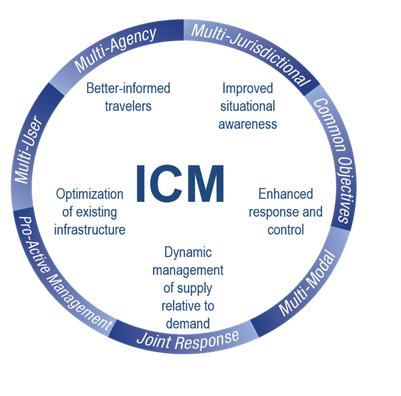
Implementation Examples Highlighted at the October 2016 Stakeholder Summit:
Integrated Corridor Management and Transportation Systems Management & Operations (FDOT and Broward MPO)
The I-95 corridor encompasses multiple modes of transportation, and several agencies are responsible for system operation. FDOT’s Transportation System Management and Operations (TSM&O) program aims to manage transportation systems (i.e. freeway system, arterial system, and rail system) as an integrated system. The Broward MPO was awarded an FHWA grant to implement integrated corridor management (ICM) for the I-95 corridor. FDOT is co-managing the grant with the MPO. ICM can increase reliability while reducing travel time and delay.
FDOT has identified six goals of the planning grant:
The ICM Program is relevant to the following facility/place types and performance measures:
Integrated Corridor Management and Transportation Systems Management & Operations (FDOT and Broward MPO)
The I-95 corridor encompasses multiple modes of transportation, and several agencies are responsible for system operation. FDOT’s Transportation System Management and Operations (TSM&O) program aims to manage transportation systems (i.e. freeway system, arterial system, and rail system) as an integrated system. The Broward MPO was awarded an FHWA grant to implement integrated corridor management (ICM) for the I-95 corridor. FDOT is co-managing the grant with the MPO. ICM can increase reliability while reducing travel time and delay.
FDOT has identified six goals of the planning grant:
- Improve accessibility for corridor travelers through a multimodal approach.
- Provide travelers with informational tools to make smart travel choices.
- Manage the corridor to improve the network to move goods along a virtual freight network.
- Improve the corridor’s safety record through a multimodal approach.
- Help partners employ an integrated approach and corridor-wide perspective.
- Manage the corridor holistically under all conditions (normal, incident, and emergency conditions).
The ICM Program is relevant to the following facility/place types and performance measures:
- SIS Highway Corridors, Primary Commerce & Primary Multimodal Facilities
- Measures of Vehicle Congestion and Reliability
Complete Streets and Other Localized Initiatives Program (Broward MPO)
The Broward MPO created the CSLIP program while developing its 2040 Long Range Transportation Plan to prioritize and implement complete streets projects. The MPO Board set aside $571 million for the CSLIP through 2040 to fund, bicycle and pedestrian improvements, traffic calming, mobility hubs, greenways, and ITS projects, among others. MPO staff developed a process for allocating the funds. In this process, municipalities apply for funding for a specific project. With their application, they must submit a resolution indicating that the community supports the project. The MPO does not require municipalities to be Local Agency Program certified to win a grant award. MPO staff reviews, ranks and selects the highest-ranking projects. The MPO provides funding and FDOT programs and builds the selected projects.
For more information on the CSLIP program, visit the Broward MPO’s CSLIP webpage.
The CSLIP program is relevant to the following facility/place types and performance measures:
The Broward MPO created the CSLIP program while developing its 2040 Long Range Transportation Plan to prioritize and implement complete streets projects. The MPO Board set aside $571 million for the CSLIP through 2040 to fund, bicycle and pedestrian improvements, traffic calming, mobility hubs, greenways, and ITS projects, among others. MPO staff developed a process for allocating the funds. In this process, municipalities apply for funding for a specific project. With their application, they must submit a resolution indicating that the community supports the project. The MPO does not require municipalities to be Local Agency Program certified to win a grant award. MPO staff reviews, ranks and selects the highest-ranking projects. The MPO provides funding and FDOT programs and builds the selected projects.
For more information on the CSLIP program, visit the Broward MPO’s CSLIP webpage.
The CSLIP program is relevant to the following facility/place types and performance measures:
- Primary Multimodal, Hybrid, and Primary Commerce Facilities
- Multimodal Districts/Nodes and Lower Intensity Mixed Use Places
- Measures for Walking & Bicycling Facilities, Transportation Funding by Mode, and Mode Share
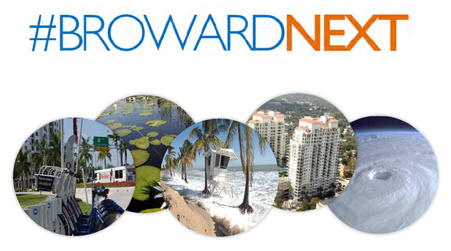
BrowardNEXT (Broward County Planning Council)
Broward County has completed a comprehensive rewrite of the Broward County Land Use Plan. The new plan, called BrowardNEXT, replaces the previous plan that was adopted in 1989. The BrowardNEXT plan addresses regional issues in several ways:
The BrowardNEXT effort to update the Broward County Land Use Plan is relevant to the following facility/place types and performance measures:
Downtown Fort Lauderdale RAC Land Use Plan Amendment (Broward County Planning Council & City of Fort Lauderdale)
The Broward County Planning Council worked with the City of Fort Lauderdale to approve an amendment to the Broward County Land Use Plan to allow an additional 5,000 dwelling units in Fort Lauderdale’s Downtown Regional Activity Center (RAC). The City suggested that the increase in dwelling units could facilitate more travel by walking, bicycling and transit and decrease auto trips because of their proximity to employment and retail. Because tools were not available to accurately estimate the transportation impacts of the increased density, a transportation monitoring component was added to the amendment’s approval.
The land use plan amendment is relevant to the following facility/place types and performance measure:
Broward County has completed a comprehensive rewrite of the Broward County Land Use Plan. The new plan, called BrowardNEXT, replaces the previous plan that was adopted in 1989. The BrowardNEXT plan addresses regional issues in several ways:
- Prioritizes redevelopment in downtowns and transit hubs
- Consolidates multimodal districts with Regional Activity Center, Local Activity Center, Transit Oriented Corridor, Transit Oriented District, and mixed use district designations now in one Activity Center designation
- Recognizes the combined cost of housing and transportation
- Promotes sustainable funding
- Creates a countywide multimodal level of service.
The BrowardNEXT effort to update the Broward County Land Use Plan is relevant to the following facility/place types and performance measures:
- All place types in the Aspirational Future Vision Map
- Measures for Population and Employment Density, Road Miles Meeting Level of Service Criteria, and Mode Share
Downtown Fort Lauderdale RAC Land Use Plan Amendment (Broward County Planning Council & City of Fort Lauderdale)
The Broward County Planning Council worked with the City of Fort Lauderdale to approve an amendment to the Broward County Land Use Plan to allow an additional 5,000 dwelling units in Fort Lauderdale’s Downtown Regional Activity Center (RAC). The City suggested that the increase in dwelling units could facilitate more travel by walking, bicycling and transit and decrease auto trips because of their proximity to employment and retail. Because tools were not available to accurately estimate the transportation impacts of the increased density, a transportation monitoring component was added to the amendment’s approval.
The land use plan amendment is relevant to the following facility/place types and performance measure:
- Multimodal Districts and Nodes
- Population Density
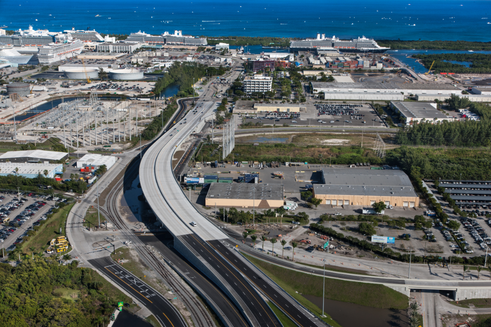 Eller Drive Overpass
Eller Drive Overpass
Freight Planning and Capacity Expansion Initiatives (FDOT and Port Everglades)
Freight at Port Everglades is expected to increase based on the expected arrival of post-panamax cargo ships and increases in regional population. The Panama Canal has been widened to accommodate the post-panamax class cargo ships, which have greater cargo capacities than existing ships. Port Everglades is working to expand and dredge the port to accommodate these larger ships.
To accommodate the increased cargo from these larger ships and to reduce the impacts of existing freight traffic, FDOT built the Eller Drive Overpass, which is an elevated roadway that connects Port Everglades with I-595 and is constructed over the railroad tracks. The overpass provides a direct connection between the port and I-595, I-75, and I-95 without a stoplight.
Freight at Port Everglades is expected to increase based on the expected arrival of post-panamax cargo ships and increases in regional population. The Panama Canal has been widened to accommodate the post-panamax class cargo ships, which have greater cargo capacities than existing ships. Port Everglades is working to expand and dredge the port to accommodate these larger ships.
To accommodate the increased cargo from these larger ships and to reduce the impacts of existing freight traffic, FDOT built the Eller Drive Overpass, which is an elevated roadway that connects Port Everglades with I-595 and is constructed over the railroad tracks. The overpass provides a direct connection between the port and I-595, I-75, and I-95 without a stoplight.
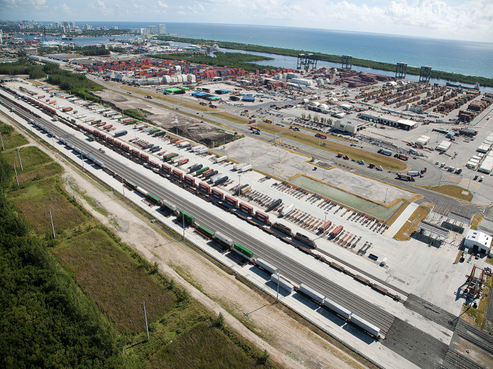 Intermodal Container Transfer Facility
Intermodal Container Transfer Facility
The port has also been expanding the railroad tracks to create a new Intermodal Container Transfer Facility (ICTF) rail yard. The ICTF allows the seamless transition of containers from ship to rail or truck to rail.
The Eller Drive Overpass and ICTF are relevant to the following facility/place types and performance measures:
The Eller Drive Overpass and ICTF are relevant to the following facility/place types and performance measures:
- SIS Highway and Rail Corridors and SIS Hub (Port Everglades)
- Primary Commerce Facilities
- Freight/Goods/Special Use Districts and Centers
- Measures for Freight/Truck Delay and Reliability
- Cargo Moved by Port Everglades and FLL Airport
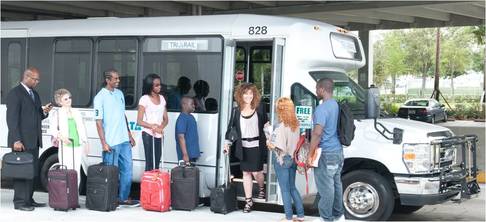 Tri-Rail Shuttle Bus Service
Tri-Rail Shuttle Bus Service
Tri-Rail Shuttle Buses (SFRTA)
SFRTA operates a shuttle bus program free to commuters that provides first and last mile connections to and from select Tri-Rail stations. The shuttle bus system is comprised of 14 routes, with three routes in Palm Beach County and 11 routes in Broward County. The system has connections to the region’s three international airports (Miami International, Fort Lauderdale/Hollywood International, and Palm Beach International).
The system provides over one-million rides per year, which is approximately 25 percent of the train ridership. The routes with the highest ridership are:
The shuttle service is funded with the SFRTA operating budget. All existing routes will be upgraded with new buses by January 2017. There is high demand for additional routes, but SFRTA does not have funding to add additional routes.
Tri-Rail shuttle buses are relevant to the following facility/place types and performance measure:
The shuttle service is funded with the SFRTA operating budget. All existing routes have been upgraded with new buses. There is high demand for additional routes, but SFRTA does not have funding to add additional routes.
Tri-Rail shuttle buses are relevant to the following facility/place types and performance measure:
SFRTA operates a shuttle bus program free to commuters that provides first and last mile connections to and from select Tri-Rail stations. The shuttle bus system is comprised of 14 routes, with three routes in Palm Beach County and 11 routes in Broward County. The system has connections to the region’s three international airports (Miami International, Fort Lauderdale/Hollywood International, and Palm Beach International).
The system provides over one-million rides per year, which is approximately 25 percent of the train ridership. The routes with the highest ridership are:
- Fort Lauderdale station to the Fort Lauderdale/Hollywood International Airport
- Fort Lauderdale station to downtown Fort Lauderdale and hospitals
- Boca Raton station to Boca Town Center
- Cypress Creek route
- Deerfield Beach route
The shuttle service is funded with the SFRTA operating budget. All existing routes will be upgraded with new buses by January 2017. There is high demand for additional routes, but SFRTA does not have funding to add additional routes.
Tri-Rail shuttle buses are relevant to the following facility/place types and performance measure:
- Multimodal Districts and Nodes
- Measures for Transit Ridership and Mode Share
The shuttle service is funded with the SFRTA operating budget. All existing routes have been upgraded with new buses. There is high demand for additional routes, but SFRTA does not have funding to add additional routes.
Tri-Rail shuttle buses are relevant to the following facility/place types and performance measure:
- Multimodal Districts and Nodes
- Measures for Transit Ridership and Mode Share
